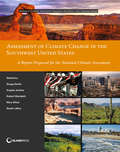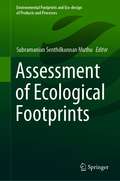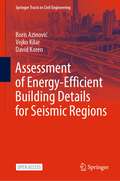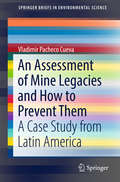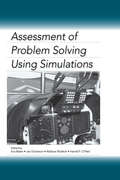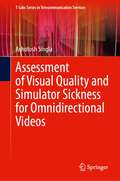- Table View
- List View
Assessment of Climate Change in the Southwest United States: A Report Prepared for the National Climate Assessment (NCA Regional Input Reports)
by Gregg Garfin, Angela Jardine, Robert Merideth, Mary Black and Sarah LeRoyA landmark study in terms of its breadth and depth of coverage, this book provides the most comprehensive, and understandable, analysis to date about climate and its effects on the people and landscapes of Arizona, California, Colorado, Nevada, New Mexico, and Utah—including the U.S.-Mexico border region and the lands of Native Nations.
Assessment of Crop Loss From Air Pollutants
by W. W. Heck O. C. Taylor TingeyDuring late 1985, the Research Management Committee (RMC) of the National Crop Loss Assessment Network (NCLAN) decided the most ap propriate way to bring the NCLAN program to a successful conclusion was to hold an international conference. It was envisaged as an opportunity to present an overview of results from the NCLAN program and as a chance to view the results in the context of ongoing research by members of the international community. * Although we wanted the Conference to have an assessment orientation, it was also intended for the Conference to focus on current state-of-knowledge. The Conference was designed to overview the needs of crop loss assessment, current approaches to assessment, progress in the development of predictive models, the use of the information for economic predictions, and the application of the data in policy decisions. Every effort was made to assure a broad representation of ideas. The Conference program was developed to evaluate major issues that address regional/national assessments of impacts of atmospheric pollutants on agricultural production. Sessions were structured to address specific issues by invited speakers, and by contributed papers and posters. First, background needs for doing loss assessment research including specific approaches and a rather detailed review of the NCLAN program were addressed (Session I). Session II addressed the needs for defining the exposure environment (e. g. extrapolating to regional concentrations and exposure characterization). Field approaches for determining crop loss were reviewed in Session III.
Assessment of Ecological Footprints (Environmental Footprints and Eco-design of Products and Processes)
by Subramanian Senthilkannan MuthuThis book highlights the concepts and assessment methods of Ecological Footprints. Ecological footprint is defined as, ”a measure of how much area of biologically productive land and water an individual, population or activity requires to produce all the resources it consumes and to absorb the waste it generates, using prevailing technology and resource management practices”. Developed in 1992 by William Rees, it was the first footprint developed followed by other footprints such as Carbon, Water and Energy. Assessment of Ecological footprints strive for comparing consumption footprint to biological capacity. This book presents five interesting chapters pertaining to the assessment of Ecological Footprints.
Assessment of Energy-Efficient Building Details for Seismic Regions (Springer Tracts in Civil Engineering)
by Boris Azinović Vojko Kilar David KorenThis open access book presents a methodology for the assessment of structural building details, taking into account the contemporary guidelines for earthquake-resistant and energy-efficient buildings. A review of structural details for energy-efficient buildings revealed that in some cases the structural system is interrupted, leading to solutions which are not suitable for earthquake-prone regions. Such typical examples would be the use of thermal insulation under the building foundation and reduction of the load-bearing elements’ dimensions – also at the potential locations of plastic hinges which are crucial for the dissipation of seismic energy. The proposed methodology of assessment favours a collaboration of architects, engineers, contractors and investors in the early stage of building design. By this the methodology enables efficient decision-making and contributes to a selection of optimal building structural details.The book starts by presenting the typical structural details of the thermal envelope of energy-efficient buildings together with the scientific background required for understanding the process of detail development from all the relevant aspects. Over 20 examples of most frequent details are described and analysed to raise awareness of the importance of earthquake resistance, sustainability, energy-efficiency and thermal comfort for users.
Assessment of Environmental Impact by Grocery Shopping Bags: An Eco-Functional Approach (EcoProduction)
by Subramanian Senthilkannan Muthu Yi LiThis book reviews the manufacturing processes of different shopping bags used for grocery purposes, life cycle impacts, modelling of life cycle impacts, carbon and eco-footprints in different countries, consumption of shopping bags in different countries, consumer behaviour of shopping bags in various countries and its relation to eco-impact, assessment of functionality of shopping bags, concept and framework of eco-functional assessment of shopping bags, biodegradation of shopping bags, etc.
Assessment of Hydrogen Energy for Sustainable Development (NATO Science for Peace and Security Series C: Environmental Security)
by John W. Sheffield Çigdem SheffieldFossil fuel prices continue to rise and, at the same time, environmental policies are demanding a reduction in greenhouse gases and toxic emissions. A coherent energy strategy is needed: one that addresses both energy supply and demand and takes into account the whole energy lifecycle, from fuel production to the end-users of energy systems. This book examines hydrogen energy technologies and infrastructure development.
Assessment of Key Issues in the Coloration of Polyester Material (Textile Progress Ser.)
by Renzo ShameyThis book addresses the problems in the dyeing of polyester textile materials in various forms and provides an overview of various textile operations for polyester. It presents various key steps and critical factors involved in the production of dyed polyester textile materials.
Assessment of Key Issues in the Coloration of Polyester Material (Textile Progress Ser.)
by Renzo ShameyThis book addresses the problems in the dyeing of polyester textile materials in various forms and provides an overview of various textile operations for polyester. It presents various key steps and critical factors involved in the production of dyed polyester textile materials.
The Assessment of Learning in Engineering Education: Practice and Policy
by John HeywoodExplores how we judge engineering education in order to effectively redesign courses and programs that will prepare new engineers for various professional and academic careers Shows how present approaches to assessment were shaped and what the future holds Analyzes the validity of teaching and judging engineering education Shows the integral role that assessment plays in curriculum design and implementation Examines the sociotechnical system’s impact on engineering curricula
The Assessment of Learning in Engineering Education: Practice and Policy
by John HeywoodExplores how we judge engineering education in order to effectively redesign courses and programs that will prepare new engineers for various professional and academic careers Shows how present approaches to assessment were shaped and what the future holds Analyzes the validity of teaching and judging engineering education Shows the integral role that assessment plays in curriculum design and implementation Examines the sociotechnical system’s impact on engineering curricula
An Assessment of Mine Legacies and How to Prevent Them: A Case Study from Latin America (SpringerBriefs in Environmental Science)
by Vladimir Pacheco CuevaThis book seeks to enrich the growing literature on mine legacies by examining a case study of a small abandoned mine in Latin America. Using a combination of Rapid Rural Appraisal and secondary source analysis, this study assessed some of the most damaging legacies of the San Sebastian mine in eastern El Salvador, compared the country’s mine closure legislation against world’s best practice standards and provided strategies for awareness, prevention and remediation. The most damaging legacy to the environment is that of Acid Mine Drainage (AMD) contamination of the local river. The impact of AMD is felt well beyond the mining district and the costs of prevention and remediation were found to be significant. Apart from environmental legacies, the mine also left a number of socio-economic legacies including: limited access to non-polluted water that results in San Sebastian residents devoting a high proportion of their income in obtaining water, lost opportunities due to the cessation of mining, uncertain land tenure situation and increasing growth of ASGM activities that exacerbate already existing environmental pollution due to use of mercury. The study also found that the state’s capacity to ensure compliance with the law is very weak and that in many important respects the country’s current legal framework does not meet world’s best practice when it comes to mine closure requirements.The findings are important because they demonstrate that the lack of closure planning can lead to private operators socializing the costs of pollution. The study also shows that the lack of state capacity may result in extractive projects becoming socio-economic liabilities in the long term.
Assessment of Polymeric Materials for Biomedical Applications (Emerging Materials and Technologies)
by Vijay Chaudhary Sumit Gupta Pallav Gupta Partha Pratim DasThis book initiates with an introduction to polymeric materials, followed by various classifications and properties of polymeric implant material including various development methods of polymeric materials and their characterization techniques. An overview of various toxicology assessments of polymeric materials and polymeric materials for drug delivery system is also included. Design and analysis of polymeric materials-based components using Ansys software along with polymeric materials for additively manufactured artificial organs are also discussed. Features: Addresses assessment of polymeric materials in biomedical sciences, including classification, properties, and development of polymeric implants. Covers various topics in the field of tissue regeneration. Discusses biocompatibility, toxicity, and biodegradation of polymeric materials. Explores wide-scale characterization to study the effect of inclusion size on the mechanical properties of polymeric materials. Reviews limitations and future directions on polymeric material with emphasis on biocompatibility. This book is aimed at graduate students and researchers in biomaterials, biomedical engineering, composites, and polymers.
Assessment of Polymeric Materials for Biomedical Applications (Emerging Materials and Technologies)
by Vijay Chaudhary Sumit Gupta Pallav Gupta Partha Pratim DasThis book initiates with an introduction to polymeric materials, followed by various classifications and properties of polymeric implant material including various development methods of polymeric materials and their characterization techniques. An overview of various toxicology assessments of polymeric materials and polymeric materials for drug delivery system is also included. Design and analysis of polymeric materials-based components using Ansys software along with polymeric materials for additively manufactured artificial organs are also discussed. Features: Addresses assessment of polymeric materials in biomedical sciences, including classification, properties, and development of polymeric implants. Covers various topics in the field of tissue regeneration. Discusses biocompatibility, toxicity, and biodegradation of polymeric materials. Explores wide-scale characterization to study the effect of inclusion size on the mechanical properties of polymeric materials. Reviews limitations and future directions on polymeric material with emphasis on biocompatibility. This book is aimed at graduate students and researchers in biomaterials, biomedical engineering, composites, and polymers.
Assessment of Power System Reliability: Methods and Applications
by Marko ČepinThe importance of power system reliability is demonstrated when our electricity supply is disrupted, whether it decreases the comfort of our free time at home or causes the shutdown of our companies and results in huge economic deficits. The objective of Assessment of Power System Reliability is to contribute to the improvement of power system reliability. It consists of six parts divided into twenty chapters. The first part introduces the important background issues that affect power system reliability. The second part presents the reliability methods that are used for analyses of technical systems and processes. The third part discusses power flow analysis methods, because the dynamic aspect of a power system is an important part of related reliability assessments. The fourth part explores various aspects of the reliability assessment of power systems and their parts. The fifth part covers optimization methods. The sixth part looks at the application of reliability and optimization methods.Assessment of Power System Reliability has been written in straightforward language that continues into the mathematical representation of the methods. Power engineers and developers will appreciate the emphasis on practical usage, while researchers and advanced students will benefit from the simple examples that can facilitate their understanding of the theory behind power system reliability and that outline the procedure for application of the presented methods.
Assessment of Problem Solving Using Simulations
by Eva Baker Jan Dickieson Wallace Wulfeck Harold F. O’NeilThis volume explores the application of computer simulation technology to measurement issues in education -- especially as it pertains to problem based learning. Whereas most assessments related to problem solving are based on expensive and time consuming measures (i.e., think-aloud protocols or performance assessments that require extensive human rater scoring), this book relies on computerization of the major portion of the administration, scoring, and reporting of problem-solving assessments. It is appropriate for researchers, instructors and graduate students in educational assessment, educational technology, and educational psychology.
Assessment of Problem Solving Using Simulations
by Harold F. O'Neil Eva Baker Jan Dickieson Wallace WulfeckThis volume explores the application of computer simulation technology to measurement issues in education -- especially as it pertains to problem based learning. Whereas most assessments related to problem solving are based on expensive and time consuming measures (i.e., think-aloud protocols or performance assessments that require extensive human rater scoring), this book relies on computerization of the major portion of the administration, scoring, and reporting of problem-solving assessments. It is appropriate for researchers, instructors and graduate students in educational assessment, educational technology, and educational psychology.
Assessment of the Fate of Surrogates for Enteric Pathogens Resulting From the Surcharging of Combined Sewer Systems (IHE Delft PhD Thesis Series)
by Iosif Marios ScoullosIn the last ten years (2009-2019), flooding caused the death of over 48,000 people, and affected over 697 million people globally. This is expected to increase as a result of climate change, population growth and urbanisation. Floods can cause infections due to the release of water-borne pathogens from surcharged combined sewers and other sources of faecal contamination on urban surfaces such as concrete, asphalt, gravel, pavement, playground rubber tiles and grass. Using laboratory experiments with faecal indicator bacteria Escherichia coli, and with Bacillus subtilis spores, and MS2 bacteriophages under controlled exposure to simulated sunlight, this research contributes towards a better understanding of the environmental parameters that affect the concentration of pathogens in contaminated shallow water bodies and on different urban surfaces. Also, several sampling methods are assessed for the recovery of bacteria from flood-prone urban surfaces. This study suggests that given the sunlight conditions after an urban flood, the concentration of indicator organisms and of total suspended solids and the surface type it is possible to estimate the fate of selected pathogens. The observations and results presented in this study contribute to the development of policy-making tools for rapid implementation of appropriate measures to mitigate public health risks after flooding. This book:- highlights the relation of urban floods with water-borne diseases.-stresses for the first time the importance of urban surfaces (pavement, concrete, asphalt, etc.) on the inactivation of water-borne pathogens.-provides equations that can be used to develop policy-making tools for implementation of appropriate measures to mitigate public health risks after flooding.
Assessment of the Fate of Surrogates for Enteric Pathogens Resulting From the Surcharging of Combined Sewer Systems (IHE Delft PhD Thesis Series)
by Iosif Marios ScoullosIn the last ten years (2009-2019), flooding caused the death of over 48,000 people, and affected over 697 million people globally. This is expected to increase as a result of climate change, population growth and urbanisation. Floods can cause infections due to the release of water-borne pathogens from surcharged combined sewers and other sources of faecal contamination on urban surfaces such as concrete, asphalt, gravel, pavement, playground rubber tiles and grass. Using laboratory experiments with faecal indicator bacteria Escherichia coli, and with Bacillus subtilis spores, and MS2 bacteriophages under controlled exposure to simulated sunlight, this research contributes towards a better understanding of the environmental parameters that affect the concentration of pathogens in contaminated shallow water bodies and on different urban surfaces. Also, several sampling methods are assessed for the recovery of bacteria from flood-prone urban surfaces. This study suggests that given the sunlight conditions after an urban flood, the concentration of indicator organisms and of total suspended solids and the surface type it is possible to estimate the fate of selected pathogens. The observations and results presented in this study contribute to the development of policy-making tools for rapid implementation of appropriate measures to mitigate public health risks after flooding. This book:- highlights the relation of urban floods with water-borne diseases.-stresses for the first time the importance of urban surfaces (pavement, concrete, asphalt, etc.) on the inactivation of water-borne pathogens.-provides equations that can be used to develop policy-making tools for implementation of appropriate measures to mitigate public health risks after flooding.
Assessment of the Nuclear Programs of Iran and North Korea
by Jungmin KangWhen we are looking at proliferation cases, there are a number of lessons – positive and negative – learnt. First, facts reported by the IAEA are essential for the international community in assessing the compliance and risks of possible clandestine activities. Second, the IAEA verification scheme is biting when it fully exercises its verification rights, and when it is provided with the requisite cooperation. Third, when countries face questions raised by the IAEA, those that chose to turn the course and / or cooperated to remove concerns and ambiguities resolved their nuclear dossiers in a satisfactory manner and fairly swiftly. Fourth, when states adopt the course of confrontation, as are currently the cases with Iran, Syria and North Korea, the situation becomes more complicated and more difficult to resolve. Fifth, dragging non-compliance and challenging of the authority of the United Nations Security Council and the IAEA Board of Governors erodes the international non-proliferation regime. This book addresses two proliferation cases, Iran and North Korea providing extensive snapshots on the currently known nuclear programs, and analyses failures and weaknesses of past verification activities, and makes innovative suggestions for ways forward.
Assessment of Total Evacuation Systems for Tall Buildings (SpringerBriefs in Fire)
by Enrico Ronchi Daniel NilssonThis SpringerBrief focuses on the use of egress models to assess the optimal strategy for total evacuation in high-rise buildings. It investigates occupant relocation and evacuation strategies involving the exit stairs, elevators, sky bridges and combinations thereof. Chapters review existing information on this topic and describe case study simulations of a multi-component exit strategy. This review provides the architectural design, regulatory and research communities with a thorough understanding of the current and emerging evacuation procedures and possible future options. A model case study simulates seven possible strategies for the total evacuation of two identical twin towers linked with two sky-bridges at different heights. The authors present the layout of the building and the available egress components including both vertical and horizontal egress components, namely stairs, occupant evacuation elevators (OEEs), service elevators, transfer floors and sky-bridges. The evacuation strategies employ a continuous spatial representation evacuation model (Pathfinder) and are cross-validated by a fine network model (STEPS). Assessment of Total Evacuation Systems for Tall Buildings is intended for practitioners as a tool for analyzing evacuation methods and efficient exit strategies. Researchers working in architecture and fire safety will also find the book valuable.
Assessment of Visual Quality and Simulator Sickness for Omnidirectional Videos (T-Labs Series in Telecommunication Services)
by Ashutosh SinglaThis book presents extensive research on the quality of 360° video perceived by users with HMDs. The book aims to develop a set of standard guidelines for the systematic visual quality assessment of 360° videos. Firstly, conventional subjective test methods such as Absolute Category Rating (ACR) and Double Stimulus Impairment Scale (DSIS) are applied to evaluate video quality, alongside the Modified ACR (M-ACR) method newly proposed. Building on the reliability and general applicability of the procedure across different tests, a methodological framework for 360° video quality assessment is then presented. The author also analyzes simulator sickness to investigate the impact of different influencing factors. The insights gained on simulator sickness related to 360° video contribute to a better understanding of this particular use case of VR and can help to improve comfort among users by suggesting improvements in the technical specifications of 360° video and HMD technology and thus improving QoE.
Assessments of Regional and Global Environmental Risks: Designing Processes for the Effective Use of Science in Decisionmaking
by Alexander E. Farrell Jill Professor JägerAs environmental challenges grow larger in scale and implications, it is increasingly important to apply the best scientific knowledge in the decisionmaking process. Editors Farrell and J?ger present environmental assessments as the bridge between the expert knowledge of scientists and engineers on the one hand and decisionmakers on the other. When done well, assessments have a positive impact on public policy, the strategic decisions of private firms, and, ultimately, the quality of life for many people. This book is the result of an international, interdisciplinary research project to analyze past environmental assessments and understand how their design influenced their effectiveness in bringing scientific evidence and insight into the decisionmaking process. The case studies in the book feature a wide range of regional and global risks, including ozone depletion, transboundary air pollution, and climate change. Assessments of Regional and Global Environmental Risks offers several important contributions. It provides a clear account of the choices faced in the design of environmental assessments and a clear description of the lessons learned from past assessments. It illustrates why assessments are social processes, not simply reports. And, while they identify no universal, one-size-fits-all design, the authors find that, to be effective, environmental assessments must be viewed by those who produce and use them as being salient; credible in their scientific support; and legitimate, or fair in design and execution.
Assessments of Regional and Global Environmental Risks: Designing Processes for the Effective Use of Science in Decisionmaking
by Alexander E. Farrell Jill Professor JägerAs environmental challenges grow larger in scale and implications, it is increasingly important to apply the best scientific knowledge in the decisionmaking process. Editors Farrell and J?ger present environmental assessments as the bridge between the expert knowledge of scientists and engineers on the one hand and decisionmakers on the other. When done well, assessments have a positive impact on public policy, the strategic decisions of private firms, and, ultimately, the quality of life for many people. This book is the result of an international, interdisciplinary research project to analyze past environmental assessments and understand how their design influenced their effectiveness in bringing scientific evidence and insight into the decisionmaking process. The case studies in the book feature a wide range of regional and global risks, including ozone depletion, transboundary air pollution, and climate change. Assessments of Regional and Global Environmental Risks offers several important contributions. It provides a clear account of the choices faced in the design of environmental assessments and a clear description of the lessons learned from past assessments. It illustrates why assessments are social processes, not simply reports. And, while they identify no universal, one-size-fits-all design, the authors find that, to be effective, environmental assessments must be viewed by those who produce and use them as being salient; credible in their scientific support; and legitimate, or fair in design and execution.
Asset Condition, Information Systems and Decision Models (Engineering Asset Management Review)
by Joe E. Amadi-Echendu, Roger Willett, Kerry Brown and Joseph MathewAsset Condition, Information Systems and Decision Models, is the second volume of the Engineering Asset Management Review Series. The manuscripts provide examples of implementations of asset information systems as well as some practical applications of condition data for diagnostics and prognostics. The increasing trend is towards prognostics rather than diagnostics, hence the need for assessment and decision models that promote the conversion of condition data into prognostic information to improve life-cycle planning for engineered assets. The research papers included here serve to support the on-going development of Condition Monitoring standards. This volume comprises selected papers from the 1st, 2nd, and 3rd World Congresses on Engineering Asset Management, which were convened under the auspices of ISEAM in collaboration with a number of organisations, including CIEAM Australia, Asset Management Council Australia, BINDT UK, and Chinese Academy of Sciences, Beijing University of Chemical Technology, China. Asset Condition, Information Systems and Decision Models will be of particular interest to finance, maintenance, and operations personnel whose roles directly affect the capability value of engineering asset base, as well as asset managers in both industry and government.
Asset Intelligence through Integration and Interoperability and Contemporary Vibration Engineering Technologies: Proceedings of the 12th World Congress on Engineering Asset Management and the 13th International Conference on Vibration Engineering and Technology of Machinery (Lecture Notes in Mechanical Engineering)
by Joseph Mathew C. W. Lim Lin Ma Don Sands Michael E. Cholette Pietro BorghesaniThese proceedings include a collection of papers on a range of topics presented at the 12th World Congress on Engineering Asset Management (WCEAM) in Brisbane, 2 – 4 August 2017. Effective strategies are required for managing complex engineering assets such as built environments, infrastructure, plants, equipment, hardware systems and components. Following the release of the ISO 5500x set of standards in 2014, the 12th WCEAM addressed important issues covering all aspects of engineering asset management across various sectors including health. The topics discussed by the congress delegates are grouped into a number of tracks, including strategies for investment and divestment of assets, operations and maintenance of assets, assessment of assets’ health conditions, risk and vulnerability, technologies, and systems for management of assets, standards, education, training and certification.
